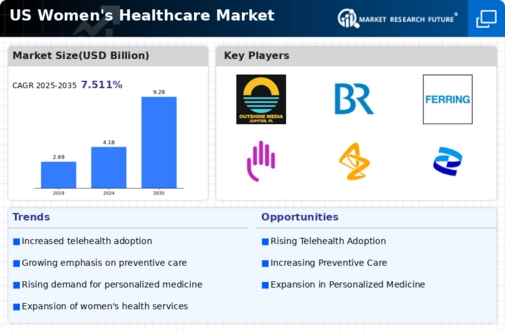Market Growth Projections
The Global US Women's Healthcare Market Industry is projected to experience substantial growth over the coming years. With a market value of 235.94 USD Billion anticipated in 2024, the industry is expected to expand at a compound annual growth rate of 7.84% from 2025 to 2035. By 2035, the market could reach an impressive 541.32 USD Billion. This growth trajectory reflects the increasing demand for comprehensive healthcare services tailored to women, driven by factors such as technological advancements, an aging population, and heightened awareness of women's health issues. The market's expansion presents opportunities for stakeholders to innovate and enhance service delivery.
Increased Focus on Mental Health
The Global US Women's Healthcare Market Industry is witnessing a growing recognition of the importance of mental health among women. Mental health issues, such as anxiety and depression, are increasingly being addressed within healthcare frameworks. This shift is prompting healthcare providers to offer integrated services that encompass both physical and mental health. The rising awareness of mental health's impact on overall well-being is likely to drive demand for specialized services, thereby contributing to the market's growth. As mental health becomes a focal point in women's healthcare, the industry may evolve to meet these emerging needs.
Aging Population and Chronic Conditions
The aging population in the United States is a significant factor influencing the Global US Women's Healthcare Market Industry. As women age, they often face a higher prevalence of chronic conditions such as heart disease, diabetes, and osteoporosis. This demographic shift necessitates tailored healthcare services that address the unique health challenges faced by older women. The market is expected to expand as healthcare providers adapt to these needs, potentially reaching a valuation of 541.32 USD Billion by 2035. The increasing demand for specialized care for chronic conditions among aging women underscores the importance of this driver in the industry.
Rising Demand for Preventive Healthcare
The Global US Women's Healthcare Market Industry is experiencing a notable increase in demand for preventive healthcare services. Women are increasingly prioritizing their health, leading to a surge in routine screenings and wellness check-ups. This trend is reflected in the growing utilization of services such as mammograms and Pap smears, which are essential for early detection of health issues. The emphasis on preventive care is likely to drive market growth, contributing to the projected market value of 235.94 USD Billion in 2024. As awareness of women's health issues expands, the industry may see further investment in preventive healthcare initiatives.
Technological Advancements in Healthcare
Technological innovations are transforming the Global US Women's Healthcare Market Industry by enhancing the quality and accessibility of healthcare services. The integration of telemedicine, wearable health devices, and mobile health applications is facilitating better health management for women. These advancements enable women to monitor their health conditions remotely and access healthcare professionals conveniently. As a result, the market is poised for growth, with projections indicating a rise to 541.32 USD Billion by 2035. The adoption of technology not only improves patient outcomes but also streamlines healthcare delivery, making it a crucial driver in the industry.
Regulatory Support and Policy Initiatives
Regulatory support and policy initiatives play a pivotal role in shaping the Global US Women's Healthcare Market Industry. Government programs aimed at improving women's health access, such as the Affordable Care Act, have expanded coverage for preventive services and reproductive health. These initiatives are likely to enhance healthcare accessibility, thereby driving market growth. As policies evolve to support women's health, the industry may experience increased investment and innovation. This supportive regulatory environment is essential for fostering advancements in women's healthcare services and ensuring that women receive the care they need.






















Leave a Comment